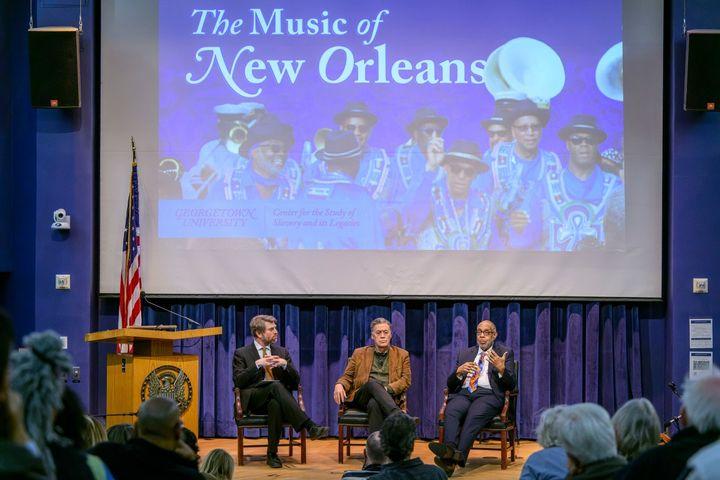Georgetown announced March 17 the formation of the Center for the Study of Slavery and Its Legacies (CSSL), an academic initiative for research and interdisciplinary work to strengthen the community’s understanding of slavery and the university’s own history.
In 1838, the Maryland Province of the Society of Jesus who ran the university sold 314 enslaved people, known as the GU272+, to financially sustain the university. The CSSL will engage with faculty and student research, teaching efforts and collaborative programs that support Georgetown’s promise to confront its roots in slavery.
Adam Rothman, the founding director of the CSSL, said the new center builds upon several university initiatives, making learning about Georgetown’s past more accessible.
“Georgetown’s history and historical involvement with slavery was never a secret,” Rothman told The Hoya. “People have been writing about it for a long time, but it was not widely known by the Georgetown community or the broader public. So I felt that one of our most important obligations as a university was to try to make this history known and to teach it.”
Rothman also curates the Georgetown Slavery Archive, a repository on the Maryland Jesuits, Georgetown University and slavery. The archive was created by the Archives Subgroup of the Georgetown University Working Group on Slavery, Memory, and Reconciliation and is one of many initiatives by Georgetown to research the university’s role in perpetuating slavery and to make reparations for Georgetown’s past.
Rothman said he is working to engage students and several academic departments in the CSSL, something he hopes will make a lasting impact.
“I think it’s really important that each successive cohort of students, faculty, staff and the growing alumni community understand their history,” Rothman said. “I think having the center as a permanent fixture at Georgetown will help to do that, so we don’t have to go through a whole working group again, 10 or 20 years from now. This knowledge will be just part of our community’s consciousness.”
Students can get involved by enrolling in classes that connect to the history of slavery, taking the virtual walking tour of sites on campus that have a legacy of slavery and reaching out to the CSSL and faculty about their research, Rothman said.
The CSSL’s March 18 inaugural event featured a screening of “City of a Million Dreams,” a film that explores the rise of jazz music within the racial justice movement. Jason Berry (CAS ’71) directed the film, which is based on a book he wrote by the same title.
Berry said through years of research on race relations, he has identified jazz music as an important focal point and catalyst for liberation.
“I’ve come to see the birth of jazz and the rise of the music in the 1890s as the beginning of a counter narrative to the white South,” Berry told The Hoya.
“The music sings of freedom, particularly in the gospel music — religious music that is so much a part of the repertoire of the marching bands during funerals. Jazz is a metaphor of democracy to me,” Berry added.

The film follows Michael White, a leading jazz clarinetist who has experienced the evolution of the musical tradition in New Orleans and its ability to inspire people.
White said jazz is both a vehicle of democracy but also an important form of personal expression and community bonding.
“In the playing of jazz, you find ways of showing democracy but also countering invisibility by having individual songs and individual expression and collective expression as well,” White told The Hoya. “It allows for all ethnicities and individuals to create and contribute to the mix of what the music becomes. It’s the ultimate way of incorporating diversity.”
The Saturday screening event, followed by a performance by White’s jazz quartet, launched an ongoing series of efforts by the CSSL to address the legacy of slavery at Georgetown.
Maurice Jackson — professor of history, African American studies and music — said the CSSL will increase student engagement with materials and lessons about Georgetown’s relationship with slavery.
“To understand today, you must understand yesterday. That’s why student participation becomes so important, and that’s why we hope that students start using the archive,” Jackson said.
“It should not take this long for the university to mandate that every student who comes to Georgetown knows a bit of the history,” he said.
Mary Beth Corrigan — the curator of the Collections on Slavery, Memory, and Reconciliation — said the CSSL will provide an opportunity to discuss and raise money for continuing memorialization efforts on campus.
“That’s always been an ongoing story,” Corrigan said. “I think it will provide a real touchstone for people who are interested in the subject and interested in the role Georgetown is taking in this, not just on campus but in the broader academic community itself.”
Rothman said he does not see the CSSL dissolving any time soon and hopes it maintains a continuous presence at the university.
“There’s something about having a sense of the past alive with us that it continues to shape, the way we weave through the world,” Rothman said. “That’s particularly true of the history of slavery and what came after in this country. And it’s just incredibly important to reckon with that history. It can’t be hidden away.”





















